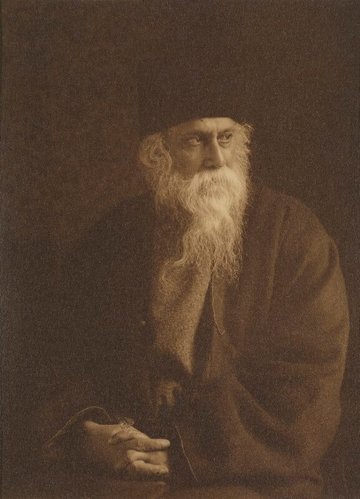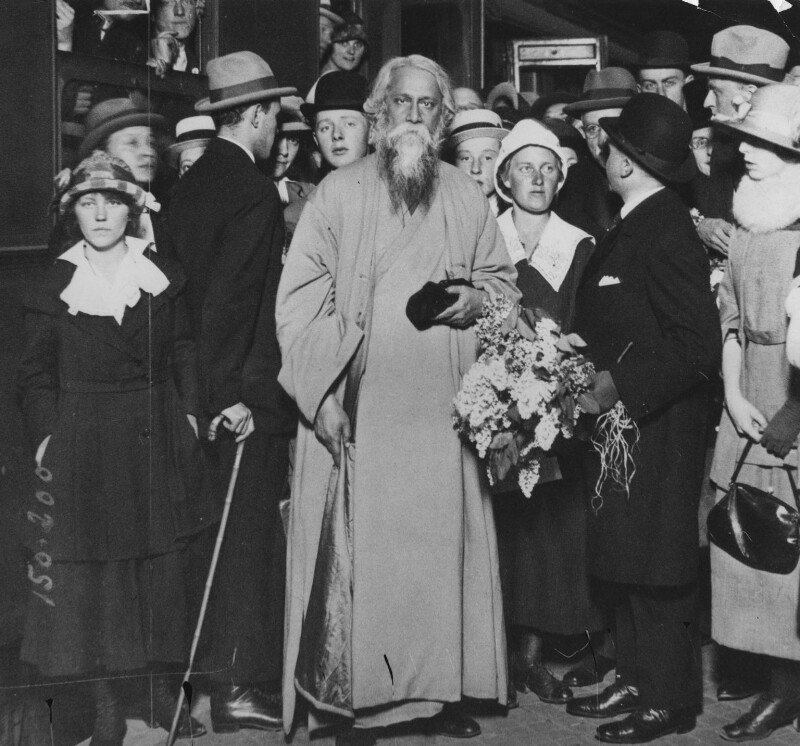
Rabindranath Tagore
‐
Nobel Prize-winning poet and educationalist
Place of birth
Date of arrival to Britain
Location(s)
Hampstead
NW3 1AW
United Kingdom 37 Alfred Place West
(now Thurloe Street)
London
SW7 2L
United Kingdom
Place of death
Calcutta, India
Date of time spent in Britain
10 October 1878 – February 1880, 10 September – 9 October 1890, 16 June – 19 October 1912, 19 April – 3 September 1913, 5 June – 6 August 1920, 24 March – 16 April 1921, 4 August – 20 August 1926, 11 May – July 1930, 22 December 1930 – January 1931
About
Rabindranath Tagore was the son of Debendranath Tagore (1817–1905) and Sarada Devi. The Tagores were one of the leading families of Calcutta, whose estates and assets were built up by Rabindranath's grandfather Dwarkanath Tagore (1794–1846) and consolidated by his father, Debendranath, who headed the Brahmo Samaj movement (a Hindu Reform movement) in Bengal. Rabindranath was the fourteenth child and eighth son of his parents. His elder brother, Satyendranath, was the first Indian to compete and pass the ICS competitive exams in London and was posted to the Indian Civil Service in Bombay. Tagore went to Britain in 1878 and attended lectures at University College, London, but returned to India before he could receive a degree. Tagore's resistance to rote learning inspired him to build a school, Patha Bhavana, at Santiniketan (in the Bengali countryside) in 1901 with only five students.
Tagore is best known as a Bengali literary figure – he experimented in all literary genres (except verse epic), composed about 2,500 songs (words and music) and painted, towards the end of his life, nearly 3,000 paintings. He wrote poems and stories mainly in his mother tongue, Bengali. The Tagore that the world beyond India came to know was catapulted to fame by the award of the Nobel Prize in Literature. In November of 1912 Gitanjali (‘Song-offering’) was published in a limited edition of 750 copies by the India Society of London. William Rothenstein had brought Tagore's work to the attention of the India Society and William Butler Yeats provided the introduction. In 1913 it was printed again by Macmillan, and on 16 November 1913 news of the award reached him in Santiniketan.
Subsequently, he toured much of the world and became the world’s first intercontinental literary star. Macmillan published a number of translations of Tagore's poems and stories after this success. A number of Tagore's plays were performed in London by British and Indian troupes. Tagore's international tours were also an opportunity for Tagore to speak against war and nationalism, to promote pan-Asianism and to expound India's spiritual heritage, his aesthetic and educational philosophy and his ‘poet's religion’. With his fame, Tagore amassed more wealth, which he was able to invest in his school at Santiniketan and the university, Visva-Bharati. The school and university attracted money and foreign scholars and students from all over the world, from C. F. Andrews and E. J. Thompson to Indira Nehru (later Gandhi) and Sylvain Levi. In 1919 Tagore returned the knighthood he had received from the British Government in 1915 as a protest against the Amritsar Massacre.
He died on 7 August 1941 at 6 Dwarkanath Tagore Lane, Jorasanko, Calcutta, in the house where he was born.
C. F. Andrews, Annie Besant, Bhabani Bhattacharya (translated poems in The Golden Boat (1932)), Katherine Bradley, Robert Bridges (edited one of Tagore's poems from Gitanjali for his 1915 anthology, The Spirit of Man), Edward Carpenter, J. Estlin Carpenter, Harindranath Chattopadhyaya, Edith Emma Cooper, Kedar Nath Das Gupta (director of plays), R. C. Dutt, Leonard Elmhirst, Jacob Epstein (Tagore sat for a bust in Epstein's studio in August 1926), A. H. Fox-Strangway, M. K. Gandhi, Patrick Geddes, Manmohan Ghose (translated Tagore's 'Paras Pathar'), Iseult Gonne, E. B. Havell, Heinrich Meyer-Benfey, Helene Meyer-Franck, Thomas Sturge Moore, Henry Morley (Professor of English Literature at UCL), Sarojini Naidu, Jawaharlal Nehru, W. W. Pearson, Ezra Pound, Ernest Rhys, Alice Richardson, William Rothenstein, Kshitish Chandra Sen (was studying in Cambridge when Tagore was in England in 1912 and translated some of Tagore's work), Uday Shankar, St Nihal Singh (discussed Amritsar in July 1920 in London, from which Singh wrote an article for The Hindu (23 July 1920), Hasan Shahid Suhrawardy (met at Oxford in 1913), Abanindranath Tagore (nephew), Rathindranath Tagore (son), Satyendranath Tagore (brother), E. J. Thompson, Evelyn Underhill, H. G. Wells, William Butler Yeats.
Publications in Britain between 1912 and 1941:
Gitanjali (London: India Society, 1912)
Glimpses of Bengal Life (London: Luzac & Co., 1913)
The Crescent Moon (London: Macmillan, 1913)
The Gardener (London: Macmillan, 1913)
Sadhana (London: Macmillan, 1913)
Chitra (London: India Society, 1914)
One Hundred Poems of Kabir (London: India Society, 1915)
Hungry Stones and Other Stories (London: Macmillan, 1916)
Fruit-Gathering (London: Macmillan, 1916)
Reminiscences (London: Macmillan, 1917)
Mashi and other Stories (London: Macmillan, 1918)
Home and the World (London: Macmillan, 1919)
The Wreck (London: Macmillan, 1921)
Glimpses of Bengal (London: Macmillan, 1921)
Gora (London: Macmillan, 1923)
Broken Trees and Other Stories (London: Macmillan, 1925)
The Religion in Man (London: Allen & Unwin, 1931)
The Child (London: Allen & Unwin, 1931)
The Golden Boat (London: Allen & Unwin, 1932)
Collected Poems and Plays (London: Macmillan, 1936)
Andrews, C. F., Letters to a Friend (London: Allen & Unwin, 1928)
Calcutta Municipal Gazette: Tagore Memorial Special Supplement, first published 13 September 1941, reprinted 9 May 1986 (Kolkata: Kolkata Municipal Corporation & New Age, 2002)
Collins, Michael, Empire, Nationalism and the Postcolonial World: Rabindranath Tagore's Writings on History, Politics and Society (London: Routledge, 2011)
Dasgupta, R. K., Rabindranath Tagore and William Butler Yeats: The Story of a Literary Friendship (Delhi: University of Delhi, 1965)
Dasgupta, Uma (ed.) Rabindranath Tagore: My Life in Words (New Delhi: Penguin Viking, 2006)
Dutta, Krishna and Robinson, Andrew, Rabindranath Tagore: The Myriad-Minded Man (London: Bloomsbury, 1995)
Dutta, Krishna and Robinson, Andrew (eds) Selected Letters of Rabindranath Tagore (Cambridge: Cambridge University Press, 1997)
Kripalani, Krishna, Rabindranath Tagore: A Biography (London: Oxford University Press, 1962)
Kundu, Kalyan, Bhattacharya, Sakti and Sircar, Kalyan, Imagining Tagore: Rabindranath and the British Press (1912–1941) (Calcutta: Sahitya Samsad, 2000)
Nandy, Ashis, The Illegitimacy of Nationalism: Rabindranath Tagore and the Politics of Self (Delhi and Oxford: Oxford University Press, 1994)
Radice, William, 'Tagore, Rabindranath (1861–1941)', Oxford Dictionary of National Biography (Oxford University Press, 2004) [http://www.oxforddnb.com/view/article/36404]
Rhys, Ernest, Rabindranath Tagore: A Biographical Study (London: Macmillan, 1915)
Rothenstein, William and Lago, Mary McClelland, Imperfect Encounter: Letters of William Rothenstein and Rabindranath Tagore, 1911–1914. Edited, with an Introduction and Notes by Mary McClelland Lago (Cambridge, MA: Harvard University Press, 1972)
Sen Gupta, Kalyan, The Philosophy of Rabindranath Tagore (Aldershot: Ashgate, 2005)
Tagore, Rabindranath, Rabindranath Tagore: 1861–1961. A Centenary Volume (New Delhi: Sahitya Akademi, 1961)
Tagore, Rabindranath and Elmhirst, L. K., Rabindranath Tagore: Pioneer in Education. Essays and Exchanges Between Rabindranath Tagore and L. K. Elmhirst (London: John Murray, 1961)
Thompson, Edward J., Rabindranath Tagore: Poet and Dramatist (n.p.: Oxford University Press, 1926)
Thompson, E. P., Alien Homage: Edward Thompson and Rabindranath Tagore (Delhi: Oxford University Press, 1993)
Correspondence with Robert Bridges, Bodleian Library, Oxford
Letters to E. J. Thompson, Bodleian Library, Oxford
Correspondence with Macmillan, Add. MS 55004, British Library, St Pancras
Rothenstein Mss, Asia and Africa Studies Reading Room, British Library, St Pancras
Letters to Elizabeth Sharpe, Mss Eur. B 280, Asia and Africa Studies Reading Room, British Library, St Pancras
Correspondence and papers, Elmhirst Centre, Dartington
Letters to Sir William Rothenstein, Houghton Library, Harvard University
Documentary footage, Film and Video Archive, Imperial War Museum, London
'Rabindranath Tagore', Channel 4, 3 July 1986, National Film and Television Archive, British Film Institute, London
Correspondence with Sir Patrick Geddes, National Library of Scotland, Edinburgh
Correspondence and literary papers, Historical Manuscripts Commission, National Register of Archives
Macmillan Company Archives, New York Public Library
Correspondence with T. S. Moore, Senate House Library, London
Correspondence and papers, Rabindra Bhavan, Visva-Bharati, Santiniketan
For image and copyright details, please click "More Information" in the Viewer.

Rabindranath Tagore by Unknown photographer, gelatin silver print, 1920s-1930s, NPG x198372
© National Portrait Gallery, London, http://creativecommons.org/licenses/by-nc-nd/3.0/
Image credit
Rabindranath Tagore by William Fearon Halliday, sepia toned gelatin silver print, 1920s, NPG P992
© National Portrait Gallery, London, http://creativecommons.org/licenses/by-nc-nd/3.0/
